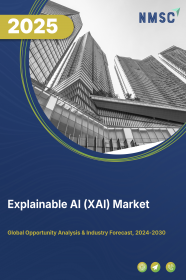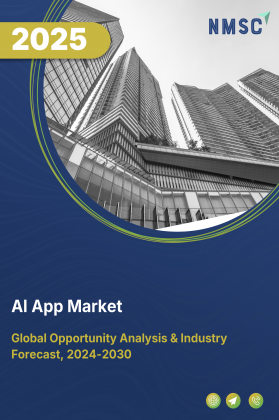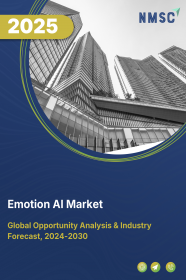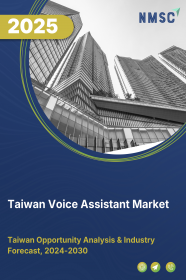
Explainable AI (XAI) Market by Component (Solution, and Services), by Explanation Methodology (Model Agnostic Methods, and Others), by AI Model Type (Traditional ML Models, and others), by Core Capability (Visualization and Reporting, Monitoring and Governance, and others), by Deployment (Cloud, On Premises, Hybrid, and Edge), by End-use Industry (BFSI, Retail & E-commerce, Healthcare & Life Sciences, and Others)– Global Opportunity Analysis and Industry Forecast, 2023–2030.
Industry: ICT & Media | Publish Date: 25-Oct-2025 | No of Pages: 486 | No. of Tables: 387 | No. of Figures: 353 | Format: PDF | Report Code : IC347
Market Overview
The global Explainable AI Market size was valued at USD 6.68 billion in 2023, and is predicted to reach USD 24.58 billion by 2030, with a CAGR of 21.3% from 2024 to 2030. Explainable AI (XAI), also known as interpretable AI or transparent AI, refers to a subset of artificial intelligence (AI) systems and methodologies that enable human users to understand and explain the reasoning behind AI-generated decisions and predictions. It focuses on providing clear and coherent explanations for the outcomes produced by AI algorithms, ensuring transparency, interpretability, and accountability.
Explainable AI includes various components, such as algorithms, software frameworks, platforms, and services that enable the development, deployment, and utilization of explainable AI models. The explainable AI market caters to various industries and sectors, including healthcare, finance, insurance, manufacturing, retail, cybersecurity, legal, government, and others.
Growing Adoption of AI Technologies in the BFSI Sector
One of the significant factors driving the growth of the explainable AI market is the increasing adoption of AI technologies in the banking, financial services, and insurance (BFSI) sector. The BFSI industry has recognized the potential of AI in revolutionizing various aspects of its operations, such as customer service, risk assessment, fraud detection, and personalized financial recommendations.
However, AI-powered systems that lack transparency and interpretability can undermine customer confidence. Explainable AI helps build trust by explaining AI decisions, as customers can understand and validate the reasoning behind recommendations, loan approvals, or risk assessments. Several banks have made the expansion of XAI techniques, methodologies, and tools a major focus. They are actively collaborating with academic and scientific communities to advance the research in XAI. Additionally, these banks are taking the lead in implementing innovative applications of explainability techniques within their organizations.
For instance, in May 2022, Temenos, a leading cloud banking platform and member of the Oracle PartnerNetwork (OPN), unveiled its collaboration with Oracle Cloud Infrastructure (OCI) to offer Temenos Explainable AI on the OCI platform. This partnership is excellent news for Oracle's global customers, particularly financial service organizations, as it allows them to leverage the advanced capabilities of Temenos Explainable AI and machine learning technologies. This collaboration expands the availability and accessibility of this powerful solution, enabling more banks and businesses to harness the benefits of XAI on the Oracle Cloud.
The rising cyber-attack cases across various sectors, including healthcare, BFSI, and the public, have significantly boosted the demand for XAI solutions. The growing digitization of healthcare systems and the interconnectedness of medical devices have raised mounting concerns about cyber-attacks. Hackers are targeting the U.S. hospitals and medical devices for cyber-attacks.
For instance, Shields Health Care Group, a reputable medical imaging service provider based in Massachusetts, recently disclosed a cybersecurity breach in March 2022. This breach resulted in the theft of sensitive data belonging to more than two million patients. The compromised information included personally identifiable details such as names, addresses, social security numbers, insurance information, and medical history records. Organizations increasingly recognize the need to enhance their cybersecurity capabilities to mitigate the risks of sophisticated cyber threats. XAI plays a crucial role in this landscape by providing transparent insights into the behavior and decision-making of AI models used for threat detection. This transparency enables cybersecurity professionals to understand how AI algorithms identify and respond to threats, leading to a reduction in response time. By leveraging XAI, organizations can effectively detect and respond to cyber threats, bolstering their overall security posture and minimizing potential damages.
Data Privacy and Regulatory Concerns
Data privacy and regulatory concerns significantly hinder the growth of the explainable AI market. As organizations increasingly leverage AI technologies, there is a growing emphasis on protecting personal data and ensuring compliance with privacy regulations such as the General Data Protection Regulation (GDPR) and other local data protection laws. The nature of XAI requires access to sensitive data, which raises concerns about data privacy, security, and the potential misuse of personal information. Striking the right balance between transparency and data protection is crucial but challenging. Organizations must navigate complex regulatory landscapes and establish robust mechanisms to safeguard sensitive data while providing understandable explanations for AI decisions.
Government Regulatory Requirements to Create Future Market Prospects
Government regulatory requirements are expected to be a significant factor that provides opportunities for the explainable AI industry in the near future. As governments and regulatory bodies become more focused on the responsible and ethical deployment of AI, they are likely to introduce regulations that mandate transparency and interpretability in AI systems. Regulations may require organizations to provide explanations and justifications for AI-based decisions, especially in sectors, such as finance, healthcare, and legal. These regulatory requirements will create opportunities to deploy explainable AI solutions as businesses and organizations seek to comply with the regulations and ensure transparency in their AI-driven decision-making processes. The demand for explainable AI is expected to be fueled by the need to meet regulatory obligations and demonstrate accountability, further driving the growth of the industry in the future.
The North America region holds a significant share of the XAI market, and is poised to maintain its dominance throughout the forecast period. Several large firms in this region are heavily involved in AI innovation and optimization, including Microsoft Corporation, Google, Inc., NVIDIA Corporation, Sentient Technologies, IBM Corporation, Intel Corporation, Salesforce, and Amazon Web Services.
Several retailers throughout this region, including fashion & apparel, electronics & technology, and automotive, have implemented AI-based solutions to improve their inventory management and supply chain operations. Both online and offline retailers use AI technologies such as natural language processing (NLP) and predictive analytics to engage customers and increase sales turnover. These cutting-edge technologies enable these retailers to generate predictive insights that lead to useful actions, thereby revolutionizing the supply chain. The implementation of AI across the region is expected to boost the demand for XAI in the region.
Moreover, various AI strategies by the U.S. Government drive the growth of the explainable AI market in the country. For instance, in May 2023, the U.S. Government announced a ground-breaking initiative to promote responsible innovation in AI and protect individuals' rights and safety. This significant initiative aligns with the principles of explainable AI, which aims to tackle concerns related to opaque AI systems by offering clear and comprehensible explanations for their decision-making.
On the other hand, Asia-Pacific is expected to show a steady rise in the explainable AI market, owing to the growing adoption of AI across industries such as healthcare, finance, retail, and manufacturing. This adoption has raised concerns about the transparency and interpretability of AI systems. As a result, there is an increasing demand for XAI solutions that can provide clear explanations for AI-driven decisions.
Moreover, the rapid advancements in AI research and developments in the Asia-Pacific region are contributing to the growth of the explainable AI market. Academic institutions, research organizations, and industry collaborations are actively exploring and developing innovative techniques and tools for explainability in AI. Organizations recognize the importance of transparent and interpretable AI systems to gain trust, meet regulatory requirements, and enhance decision-making processes.
For instance, in February 2021, Fujitsu Laboratories Ltd. and Hokkaido University strategically collaborated to develop a new technology based on the principle of XAI. Based on AI's data analysis, this technology automatically presents users with the necessary steps to achieve the desired outcome. It analyzes a vast amount of complex medical check-up data from the past and identifies the connections between different factors. This analysis presents specific steps for improvement, considering the feasibility and difficulty of implementation.
Various market players operating in the explainable AI industry include Microsoft Corporation, Google LLC, Amazon Web Services Inc., IBM Corporation, Oracle Corporation, Salesforce Inc., Databricks Inc., DataRobot Inc., SAS Institute Inc., H2O.ai Inc., NVIDIA Corporation, Palantir Technologies Inc., C3 AI Inc, Fair Isaac Corporation FICO, QlikTech International AB Qlik, Fiddler Labs Inc., TruEra Corporation, Arthur AI Inc., Seldon Technologies Limited, DarwinAI Inc (getdarwin.ai), and Others.. These companies adopt various strategies to remain dominant in the market.
For instance, in June 2025, Microsoft Corporation,Published its 2025 Responsible AI Transparency Report, outlining improved transparency tools (e.g., “Transparency Notes”) and expanded support for modalities beyond text (images, audio, video) in its AI systems.
Moreover, in August 2024, DataRobot Inc.,Introduced new features aimed at improving model interpretability and transparency—allowing users to aggregate data transformations, examine feature impact, model behaviour, and produce clearer explanations of predictions.Focused on enabling citizen-data scientists to build models that include built-in explainability and compliance tools.
In addition, in March 2024, DarwinAI Inc. (getdarwin.ai), News outlets reported that DarwinAI was acquired by Apple Inc., signaling a major strategic milestone for its explainable-AI technology and its transition into a major tech ecosystem.
Explainable AI Market Key Segments
By Component
-
Solution
-
Standalone Explainability Platforms
-
Integrated AI Platform Features
-
Open Source Tools and Libraries
-
-
Services
-
Consulting and Advisory
-
Implementation and Integration
-
Support and Maintenance
-
Managed Services
-
Custom Development
-
By Explanation Methodology
-
Model Agnostic Methods
-
Model Specific Methods
-
Example Based Methods
By AI Model Type
-
Traditional ML Models
-
Deep Learning Models
-
Foundation Models and LLMs
-
Computer Vision Models
-
Time Series & Forecasting Models
-
Multimodal Models
By Core Capability
-
Visualization and Reporting
-
Monitoring and Governance
-
Attribution and Feature Importance
-
Natural Language Explanations
-
Bias Detection and Mitigation
-
Regulatory Compliance and Reporting
By Deployment
-
Cloud
-
On Premises
-
Hybrid
-
Edge
By End-use Industry
-
BFSI
-
Credit Scoring and Loan Approvals
-
Fraud Detection and Prevention
-
Risk Assessment in Investments
-
Customer Service and Queries
-
Anti-Money Laundering (AML) Monitoring
-
-
Retail & E-commerce
-
Customer Behavior Analysis
-
Dynamic Pricing Strategies
-
Supply Chain Optimization
-
Product Recommendations
-
Inventory Management
-
Customer Segmentation
-
Marketing Attribution
-
-
Healthcare & Life Sciences
-
Medical Diagnostics and Imaging
-
Drug Discovery and Development
-
Patient Risk Stratification
-
Treatment Recommendation
-
Clinical Trial Optimization
-
Electronic Health Record Analysis
-
-
Government & Public Sector
-
Policy Decision Support
-
Public Service Delivery
-
Fraud Detection in Benefits
-
Regulatory Enforcement
-
Public Safety and Security
-
Resource Allocation
-
-
Manufacturing & Industrial
-
Predictive Maintenance
-
Quality Control and Inspection
-
Supply Chain Management
-
Production Optimization
-
Safety Monitoring
-
Energy Management
-
-
IT & Telecommunications
-
Network Optimization
-
Customer Churn Prediction
-
Service Quality Monitoring
-
Cybersecurity Threat Detection
-
Infrastructure Management
-
-
Automotive & Transportation
-
Autonomous Vehicle Decisioning
-
Fleet Management
-
Route Optimization
-
Predictive Maintenance
-
Driver Behavior Analysis
-
-
Energy & Utilities
-
Grid Management
-
Demand Forecasting
-
Equipment Monitoring
-
Energy Trading
-
Outage Prediction
-
-
Aerospace and Defense
-
Defense & National Security
-
Aircraft Design & Manufacturing
-
Predictive Maintenance
-
Autonomous Systems
-
Public Safety & Security
-
Pilot & Personnel Training
-
Cybersecurity
-
-
Media and Advertising
-
Ad Targeting & Personalization
-
Ad Delivery & Bidding Optimization
-
Dynamic Pricing
-
Content Recommendation
-
Performance Analysis & Attribution
-
Fraud Detection
-
Sentiment Analysis & Content Strategy
-
-
Other Industries
By Organization Size
-
Large Enterprise
-
Mid Market
-
Small and Medium Business
-
Public Sector Agencies and Regulators
By Commercial Model
-
License and Subscription
-
Consumption and API Pricing
-
Project Based Professional Services
-
Managed Service Subscription
By Region
-
North America
-
U.S.
-
Canada
-
Mexico
-
-
Europe
-
U.K.
-
Germany
-
France
-
Italy
-
Spain
-
Denmark
-
Netherlands
-
Finland
-
Sweden
-
Norway
-
Russia
-
Rest of Europe
-
-
Asia-Pacific
-
China
-
Japan
-
India
-
South Korea
-
Australia
-
Indonesia
-
Singapore
-
Taiwan
-
Thailand
-
Rest of Asia-Pacific
-
-
Rest of the World (RoW)
-
Latin America
-
Middle East
-
Africa
-
Key Players
-
Microsoft Corporation
-
Google LLC
-
Amazon Web Services Inc.
-
IBM Corporation
-
Oracle Corporation
-
Salesforce Inc.
-
Databricks Inc.
-
DataRobot Inc.
-
SAS Institute Inc.
-
H2O.ai Inc.
-
NVIDIA Corporation
-
Palantir Technologies Inc.
-
C3 AI Inc
-
Fair Isaac Corporation FICO
-
QlikTech International AB Qlik
-
Fiddler Labs Inc.
-
TruEra Corporation
-
Arthur AI Inc.
-
Seldon Technologies Limited
-
DarwinAI Inc (getdarwin.ai)

















 Speak to Our Analyst
Speak to Our Analyst

























